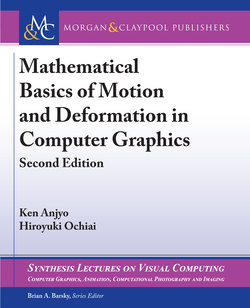Читать книгу Mathematical Basics of Motion and Deformation in Computer Graphics - Ken Anjyo - Страница 12
На сайте Литреса книга снята с продажи.
ОглавлениеCHAPTER 2
Rigid Transformation
In physics, a rigid body means as an object which preserves the distances between any two points of it with or without external forces over time. So describing rigid transformation (or rigid motion) means finding the non-flip congruence transformations parametrized over time. For a rigid body X, an animation (or a motion) X(t) indexed by a time parameter t can be described by a series of rigid transformations S(t) with X(t) = S(t)X(0), instead of dealing with the positions of all the particles consisting of X. In the following sections, a non-flip congruence transformation may also be called a rigid transformation. The totality of the non-flip rigid transformations constitutes a group, which will be denoted by SE(n), where n is the dimension of the world where rigid bodies live (n = 2 or 3). So let’s start with 2D translation, a typical rigid transformation in R2.
2.1 2D TRANSLATION
A translation Tb by a vector b ∊ R2 gives a rigid transformation in 2D. The composition of two translations and the inverse of a translation, which is denoted by , are also translations:
This can be rephrased as the totality of translations forms a group (recall Chapter 1). Moreover, they satisfy also
This means that the totality of translations forms a commutative group. This property is illustrated in Figure 2.1. A commutative group is also called abelian group named after Niels Abel. The totality of 2D translations are denoted by R2, as is the two-dimensional vector space.
Figure 2.1: Example of groups—commutative group.
Niels Henrik Abel (1802–1829)
Norway mathematician. In his 28-year life, he gave a lot of important insight, which now has become a mathematical notion, such as Abelian groups, Abelian integral, Abelian functions, named after him. Also, the Abel prize was founded in 2002, the two-hundredth anniversary of Abel’s birth. This prize is awarded to one or few outstanding mathematicians each year with six million kroner (approx. one million dollars).
2.2 2D ROTATION
A rotation in 2D centered at the origin (illustrated as in Figure 2.2) is then expressed by a matrix
Note that the angle θ ∊ R is not uniquely determined. To be more precise, two matrices Rθ and Rθ′ give the same rotation if and only if θ – θ′ is an integer multiple of 2π. The compositions of two rotations and the inverse of a rotation are again rotations:
Figure 2.2: 2D rotation.
Here denotes the inverse of Rθ. The totality of the rotations in 2D forms a group (also recall the definition of group in Chapter 1). It is denoted by
We also write as
where M(2, R) is the set of square matrices of size two, I is the identity matrix, and det is the determinant. The transpose1 of a matrix A is denoted by AT. A matrix A ∊ M(2, R) is a rotation matrix if and only if the column vectors u, v ∊ R2 of A form an orthonormal basis and the orientation from u to v is counter-clockwise. This means that a rotation matrix sends any orthonormal basis with the positive orientation to some orthonormal basis with the positive orientation.
The result of the composition of several rotations in 2D is not affected by the order. This fact comes from the commutativity; Rθ Rθ′ = Rθ′ Rθ. Note that this is never true for 3D or a higher dimensional case.
